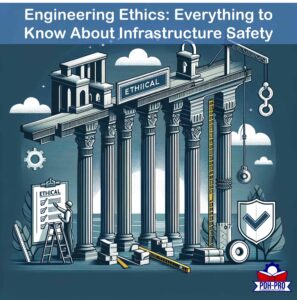Infrastructure Safety and Its Relationship to Engineering Ethics
Infrastructure safety is essential. 2.3 million workers die in work-related accidents every year.
That number accounts for only a fraction of fatalities related to infrastructure. Common engineering safety issues can result in faulty roads, which can cause fatal accidents.
All engineers must be mindful of ethics and safety in engineering. These sound like weighty concepts, but they are actually quite simple.
How should infrastructure engineers conduct themselves to prevent traffic accidents? What are environmental concerns in infrastructure development? What does people-centered engineering look like?
Answer these questions and you can keep your infrastructure safe and sound for years to come. Here is your quick guide.
Traffic Accidents
Traffic accidents are the main concern in infrastructure safety practices. Roadways must be safe for drivers and pedestrians to operate.
There are several ways that engineers and road designers can create safe driving. Of the 36,000 traffic fatalities in 2019, more than 10,000 occurred at an intersection.
Putting proper signage and traffic lights along all roadways can help. A designer can also replace the intersection with a roundabout, which encourages the driver to slow down.
Creating smoother road surfaces prevents tires from wearing down. Keeping concrete smoothed over and cleaned with water avoids accidents.
Road design should allow for clear turns and distant lanes of traffic. Trucks require far more room to turn than cars. Exits should be at shallow angles to the roadways so trucks can exit without endangering cars in their blind spots.
Many infrastructure projects come from legislators. They sneak a provision into a bill that allows for a road to get built in their district. These projects may involve inexperienced workers from the local area.
Managers must take steps to ensure that they are hiring qualified, experienced workers. They should not hire someone just because a politician or important person vouches for them. This is especially important for bridges, which can collapse if improperly constructed.
Construction Site Dangers
Construction sites are laden with dangers. Workers can fall off of ladders and raised surfaces, including cliffs and rocks. Mobile equipment can strike someone or knock over an object.
Most construction sites occur along roadways where drivers are operating. Any danger that threatens the life of a worker threatens the life of a driver. A driver can run over a worker or strike a piece of equipment as well.
Even if no accidents occur, using toxic materials and chemicals endangers workers. They can suffer from skin or respiratory irritation. The noise from their machinery can damage their hearing, especially for older workers.
Every infrastructure project must start with a comprehensive plan to create a safe work environment. Planners must consider every contingency to minimize risks.
All employees must receive education on how to deal with threats, including medical emergencies. Provide education about the latest engineering technology, as well as lessons on how to operate major tools.
Everyone involved should wear protective equipment. This includes reflective jackets and respirators.
Managers should carefully evaluate what materials they plan on using in their projects. Materials with toxic chemicals may be cheaper, but they will prove a greater risk to people. They should always go with the more expensive options if it means a safer environment.
Environmental Disasters
Any infrastructure project near a waterway must consider water contamination. Construction materials can run off into the waterway, or workers can dig into underground supplies of water. Even if a project is at some distance, the rain can wash chemicals into the water.
Many infrastructure projects build wastewater and drinking water resources. These projects need to protect against accidentally contaminating water sources. Use expensive and safe materials over inexpensive and unsafe ones.
Some projects run through natural resources. A company decides to build a road through a forest, tearing down trees.
A road in a rural area can be important. But the company should prepare an environmental impact report. They should evaluate what they can do to avoid damaging habitats.
The company should also commit itself to conservation. They should replant the trees that they torn down.
Coastal areas are vulnerable to coastal processes like storm surges and erosion. Bridges, roadways, and train tracks must resist the wear and tear of the environment.
Transportation resources should always be available before an emergency. People should be able to evacuate before a hurricane or tornado arrives. Roads should be wide and accessible to different communities.
People-Centered Engineering
Many engineering disasters have resulted from a focus on costs or time. In 1986, the Space Shuttle Challenger disintegrated shortly after take-off. The O-ring that kept gas from leaking failed.
Engineers knew that the O-ring could fail from wear and tear and cold temperatures. But NASA went ahead with the launch to save money and to get publicity from having the first teacher in space. If NASA focused on the engineers’ concerns for the astronauts, they may have avoided the disaster.
Every engineering project must prioritize the welfare of people, including those who create the project. Engineers should talk to residents, local politicians, and activists and get their input.
They should adjust their projects according to other people’s concerns. This may delay a project. But it will produce something valuable to the community and safe to use.
The Essentials of Infrastructure Safety
Infrastructure safety is not complicated. Road accidents must be a chief priority for any roadway project. Placing signs and designing clear turns can go a long way toward stopping crashes.
Every project needs a safety plan that accounts for all hazards. The key is to adopt people-centered engineering. Engineers must consider the safety of all people before anything else.
Becoming a conscientious engineer takes time. PDH-Pro helps with Texas continuing engineer education. Browse our courses today.
